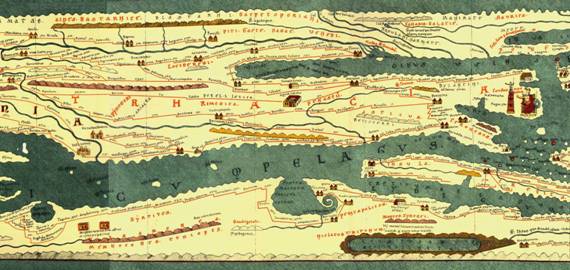

DAILY LIFE
Ancient people traveled for many reasons, though the most common one was for commerce (Rev. 18:11-18). Literary sources and coin finds confirm that Greco-Roman traders went to India in the east and to the tribes of northern Europe. Besides merchants, travel was also essential for other professions, such as ambassadors and other government officials, as well as those seeking work, for example, teachers, physicians, artisans, musicians, athletes, astrologers, and seasonal agricultural laborers. Other people attended religious festivals such as the pan-Hellenistic events that attracted athletes, coaches, and tens of thousands of spectators. Occasionally expeditions, as evident in the saga of the Argonautica (third century BC), had as their mission exploration and discovery. Young upper-class Romans often gravitated to important centers such as Athens, Alexandria, and Rhodes to study under renowned scholars.
Tourism existed even in the ancient world, as evidenced by graffiti on the royal tombs of Thebes and other prominent sites. A favorite destination was the pyramids of Egypt. Others journeyed to Athens—for which Pausanias provided a guidebook—and to Rome to see its buildings and ancient monuments. Major centers had professional tourist guides. In other places, priests often filled such a role.
By New Testament times, the Roman Empire had created an amazing system of 53,000 miles of roads extending from Scotland to Mesopotamia. Some parts are still in use today. People who traveled on such roads carried their own supplies. The wealthy would take a considerable amount of baggage, kitchen utensils, and other travel equipment as well as several slaves and pack animals.
People could stay in one of the inns along the new routes. Maps similar to modern-day road guides helped travelers to know where to stop. Unfortunately, many inns acquired the reputation of being filthy with dishonest innkeepers, and they attracted thieves and prostitutes looking for business. That is one reason why the New Testament regarded hospitality as a virtue (cf. Heb. 13:2; 3 John 5; Did. 11–13). Many synagogues included guest rooms. But lacking better options, travelers would often sleep along the side of the road, either under the open sky or in tents.
Depending on the terrain and road conditions, those on foot might average 20 miles a day. If at all possible, people in the Roman Empire preferred to travel by sea because it was cheaper and less exhausting than land journeys. A family could purchase their fare from Alexandria for two drachmae. Each passenger had to bring their own food or buy supplies every time the ship stopped at a port. The few cabins on board were for the crew so passengers would sleep on the deck. Ships tended to follow the coastline instead of heading across open water, slowing the journey. Since sea travel depended on the direction of the wind, a trip from Rome to Alexandria required about 10 days, but the way back took much longer.
All trips could be dangerous. In addition to storms, sea voyagers faced the threat of pirates. Robbers and bandits lurked on land. Also, travelers generally lacked legal protection.
Yet despite all the difficulties, travel made possible the most significant developments in the history of salvation and became one of the principal metaphors for Christian life in the Bible (Heb. 11, 1 Pet. 1:1). Abraham’s Journey to Canaan inaugurated the formation of new people. Jacob’s descent to Egypt made it possible for Israel to become a numerous nation. Israel’s return to Canaan gave Israel a homeland. The extensive commerce during the reign of Solomon (1 Kings 4:34; 9:26–28; 2 Chron. 9:20, 21) disseminated the knowledge of Israel’s God among the nations. Similarly, the constant travels of Jesus and His disciples in the New Testament made the spread of the gospel possible.

Above: reproduction of “The Tabula Peutingeriana.” Source: Wikimedia
Bibliography:
Lionel Casson, Travel in the Ancient World (London: Allen & Unwin, 1974).
Fik Meijer and Onno van Nijf,.Trade, Transport, and Society in the Ancient World: A Sourcebook (New York: Routledge, 1992).